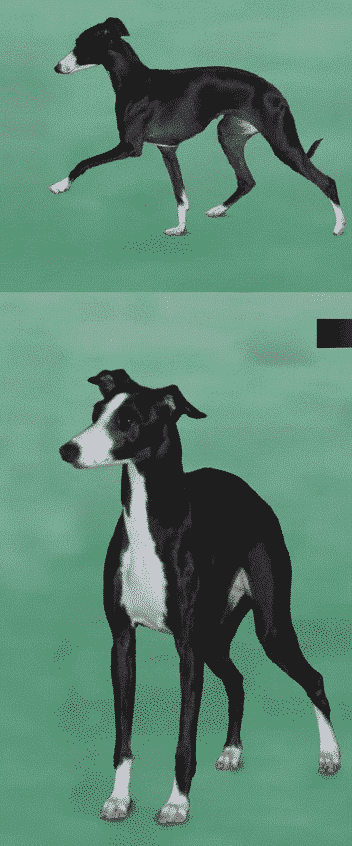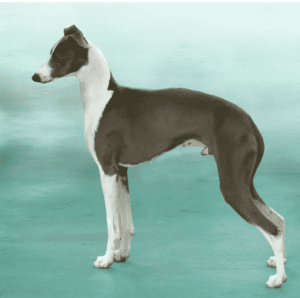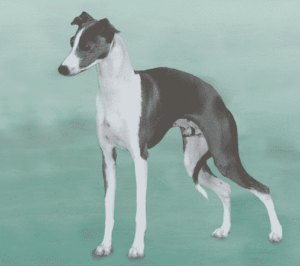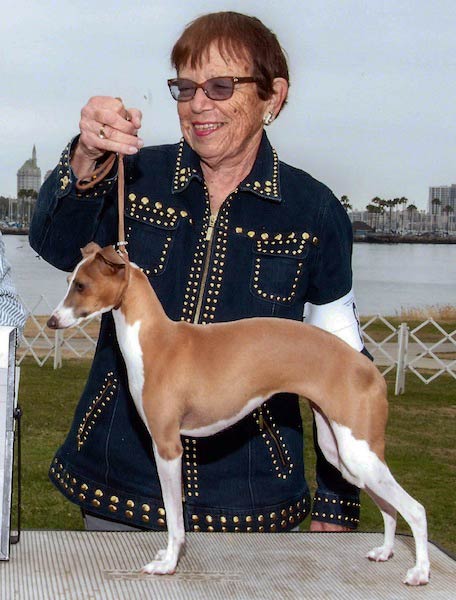 When I was asked to write another article about judging my beloved breed, I thought about the questions trainee judges—and even some experienced ones—have asked. I decided to go through the Italian Greyhound standard and make a comment or two about each point, especially the sections that seem a little unclear to some. Here is the result:
When I was asked to write another article about judging my beloved breed, I thought about the questions trainee judges—and even some experienced ones—have asked. I decided to go through the Italian Greyhound standard and make a comment or two about each point, especially the sections that seem a little unclear to some. Here is the result:
DESCRIPTION
The Italian Greyhound is very similar to the Greyhound, but much smaller and more slender in all proportions, and of ideal elegance and grace. Elegance and grace are hallmarks. Without these, proper type is missing. When one sees an IG with the strong, lithe look of a large Greyhound, but scaled down and appropriately elegant, the breed description becomes
very clear.
HEAD
Narrow and long, tapering to nose, with a slight suggestion of stop. Self-explanatory, but especially look for underjaw and no snipeyness, nor should the dog be down-faced. “A slight suggestion of stop” does not mean no stop at all.
SKULL
Rather long, almost flat. This fits in well with the “head” description. Keep in mind, too, when there is an exhibit that has what IG breeders call a “toy head.” Years ago, rounded skulls and short, snipey muzzles were common, especially among smaller specimens. This is still seen occasionally and should be faulted according to the degree to which it is apparent.
MUZZLE
Long and fine. See “Head” and “Skull” descriptions.
NOSE
Dark.By Italian Greyhound standard it may be black or brown or in keeping with the color of the dog. A light or partially pigmented nose is a fault. “Blue” IGs are actually shades of grey and almost always have a blue/grey nose. As long as that nose is in keeping with the coat color or darker (occasionally a blue IG will have a black nose) it’s all right.
TEETH
Scissors bite. By Italian Greyhound standard a badly undershot or overshot mouth is a fault. Undershot bites are extremely rare, but overshot is common. Depending on the degree, it’s preferable to judge the dog on its good qualities.
EYES
Dark, bright, intelligent, medium in size. Italian Greyhound standard states that very light eyes are a fault. Much of this breed’s charm and charisma comes from the sweet, loving, intelligent expression. The eyes, both size and color, have a great deal to do with this. The “bug-eyed” look of the old toy type heads still
appears occasionally.
EARS
Small, fine in texture, thrown back and folded except when alerted, then carried folded at right angles to the head. By Italian Greyhound standard erect or button ears severely penalized. Ears should never be erect, even on high alert. The most inept amateur handler should know how to get his/her dog to alert the ears properly. It should not be necessary for the judge to do this, but if you choose to do so, it’s best to make an interesting sound at the dog’s eye level or above. This is to check if the ears respond properly, not to animate the dog. Alerting each dog once during the class is sufficient.
NECK
Long, slender and gracefully arched. “Ewe” necks with an inelegant bulge at the front of the throat are not desirable. Although the standard calls for a long and slender neck, this doesn’t mean the longer and/or thinner the better. Everything should be in proper balance.

BODY
Of medium length, short-coupled, high at withers, back curved and drooping at hindquarters, the highest point of curve at start of loin, creating a definite tuck-up at flanks. This often gives new judges some trouble. “Medium length” is not “square.” This being a running dog that needs as much lung capacity as possible, the rib cage area is elongated whereas the loin is short. An IG with a short rib cage and long loin looks out of proportion. Familiarity with the terms of canine anatomy is important, and the IG is no exception. Compared to most breeds, the IG is “curvy,” but the topline should not be exaggerated to the point of appearing roached. The curves should be smooth, gentle, and flowing. Remember that the standard states, “high at withers.” An IG that is down at the shoulder and high in the rear is definitely incorrect.

SHOULDERS
Long and sloping. Although the shoulders should not be upright, shoulder layback of the IG is not as extreme as that of many other breeds. Correct layback is part of the necessary elements that enable the breed’s unique gait. (See “Action.”)
CHEST
Deep and narrow. To the elbow, with some rib spring and not so narrow that both front legs appear to be coming from the same hole.
FORELEGS
Long, straight, set well under the shoulder; strong pasterns, fine bone. The front legs should be set well under the dog, never at the corners like the legs of a card table.
The pasterns are shock absorbers and, although strong, should have some give to them; so they should not be
completely upright.
HINDQUARTERS
Long, well-muscled thigh, hind legs parallel when viewed from behind, hocks well let down, well-bent stifle. This gives the dog strength and drive from the rear. Although nothing is said about angulation, this should not be so extreme as to make the rear look out of balance with the front.
FEET
Hare foot with well-arched toes. Removal of dewclaws is optional. The hare foot is long and narrow, the two center toes slightly longer than the others. Feet should never be flat or splayed. Nails should be short, but not trimmed all the way to the quick as is customary in other breeds.
TAIL
Slender and tapering to a curved end, long enough to reach the hock; set low, carried low. Ring tail a serious fault, gay tail a fault. The tail is typically carried below the level of the back, in a gentle curve. Puppies can carry theirs a bit high. A wagging tail is not a
fault as long as it is set on low and is carried low. Length can be measured by holding it along the back of the leg to see if it reaches the hock joint. There is no need to wrap it around
the leg.
COAT
Skin fine and supple, hair short and glossy, like satin, and soft to the touch; self-explanatory.
COLOR
Any color and markings are acceptable except that a dog with brindle markings and a dog with the tan markings normally found on black and tan dogs of other breeds must be disqualified. Note that there is no preferred color and no preferred markings. When judging, personal preferences should be ignored. Sometimes markings can fool the eye, especially on a white dog with colored markings that can make him look down in the shoulder or sway-backed.
ACTION
High-stepping and free, front and hind legs to move forward in a straight line. Some people have trouble understanding correct IG movement. This is not a hackney or even a hackney-like gait. In hackney movement there is much up-and-down travel, but little forward propulsion. Often a stiff, “goose-stepping” gait is seen, which may be high-stepping but is not free. The front legs should have lift, but also good forward movement. At its highest, the leg is approximately parallel to the ground. There is a break at the pastern, with the foot pointing downward. The hind legs should exhibit drive from the rear and should
land freely.
SIZE
Height at withers, ideally 13 inches to 15 inches. Italian Greyhound standard states that under 13 inches or over 15 inches is not ideal. However, most IGs are between 14 and 16 inches, with males tending to be somewhat taller. Height can easily fool even experienced persons. A 13 inch dog in the ring with mostly 15 inch dogs can look considerably below the ideal.
DISQUALIFICATIONS
A dog with brindle markings. A dog with the tan markings normally found on black-and-tan dogs of other breeds. A purebred IG can’t be brindle or marked, for instance, like a Doberman, a Miniature Pinscher or a Manchester Terrier. There are many seal-colored IGs with some lighter markings in the “armpit” area; however, these are not disqualifying markings. To be disqualified, the dog would have to be black, seal or blue with tan markings in all of the places these markings are found on the mentioned breeds, including a tan patch on the vent area under the base of the tail.
Hopefully, this has cleared up some things. The IG is a miniature sighthound—a dog built and programmed to hunt using keen eyesight and considerable speed. Like other Toys, IGs are also loving companions.
Hopefully, judging them will be enjoyable. Above all, please remember the importance of seeing what is good about a dog rather than to judge by
its faults.



 When I was asked to write another article about judging my beloved breed, I thought about the questions trainee judges—and even some experienced ones—have asked. I decided to go through the
When I was asked to write another article about judging my beloved breed, I thought about the questions trainee judges—and even some experienced ones—have asked. I decided to go through the 







